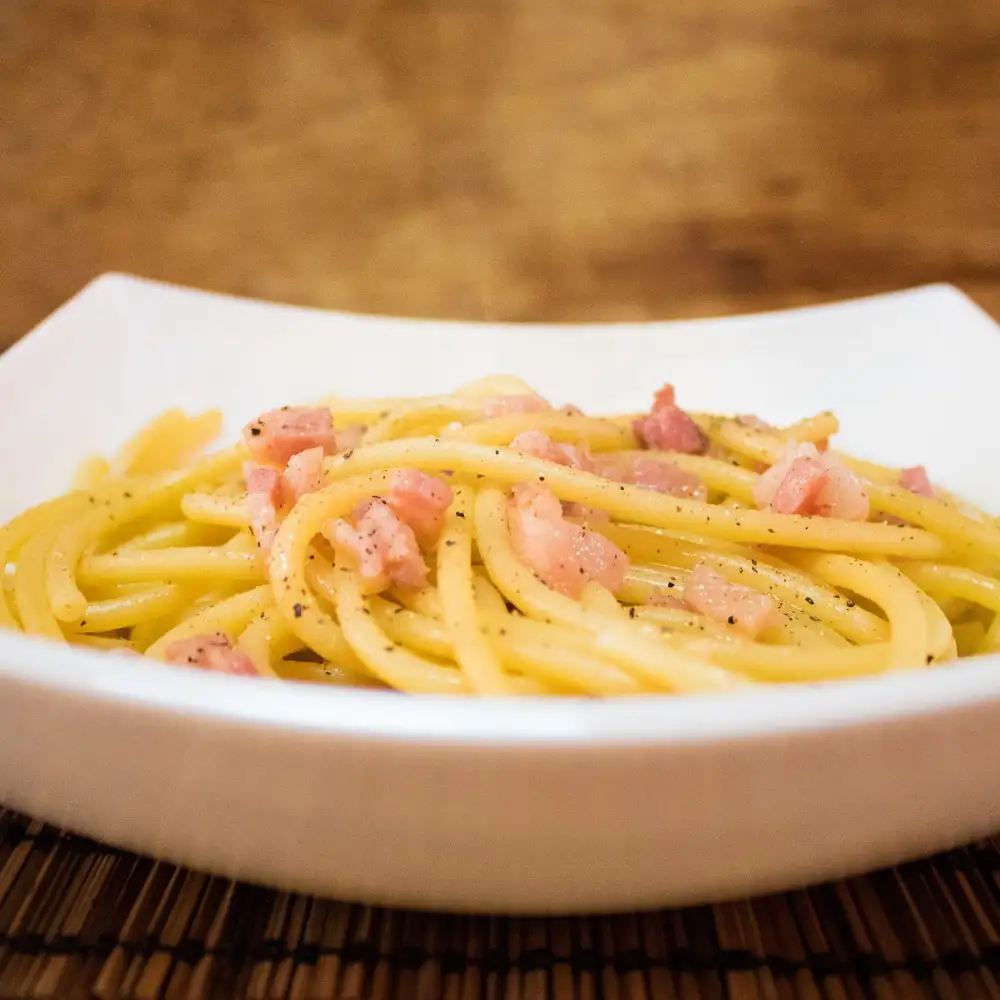Bucatini: The Irresistible Hollow Pasta Delight for Your Culinary Adventures

- History and Origins of Bucatini
- Characteristics of Bucatini Pasta
- Popular Bucatini Recipes
- 1 Classic Bucatini all'Amatriciana
- 2 Creamy Bucatini Carbonara
- 3 Bucatini with Tomato and Basil Sauce
- 4 Bucatini with Pesto Genovese
- Tips for Cooking Perfect Bucatini
- Pairing Bucatini with the Right Sauces and Ingredients
- Bucatini Variations and Alternatives
Bucatini, a beloved pasta variety in Italian cuisine, is a true delight for food enthusiasts. This hollow, tube-shaped pasta offers a unique texture and flavor that sets it apart from other pasta shapes. With its origins deeply rooted in Italy, bucatini has gained popularity worldwide for its versatility and ability to hold sauces exceptionally well. Whether you're a seasoned cook or an amateur chef, exploring the world of bucatini will undoubtedly elevate your culinary adventures to new heights. So let's dive into the history, characteristics, recipes, and tips for cooking perfect bucatini!
History and Origins of Bucatini
Bucatini, a popular pasta shape in Italian cuisine, has a rich history and fascinating origins. Its name comes from the Italian word "buco," meaning hole or hollow. Bucatini is believed to have originated in central Italy, particularly in the regions of Lazio and Abruzzo.
The exact origins of bucatini are unclear, but it is thought to have been inspired by another traditional pasta shape called maccheroni. Maccheroni was a long, tube-shaped pasta with a hole running through its center. Over time, cooks began experimenting with different sizes and shapes of maccheroni, eventually leading to the creation of bucatini.
Bucatini gained popularity in Rome during the 19th century and quickly became a staple in Roman cuisine. It was favored for its unique texture and ability to hold robust sauces. The pasta's hollow center allowed for even distribution of flavors throughout each bite.
Today, bucatini is enjoyed not only in Italy but also around the world. Its versatility and ability to pair well with various sauces make it a favorite among chefs and home cooks alike. Whether served with traditional tomato-based sauces or creamy carbonara, bucatini continues to be celebrated as a delicious and satisfying pasta choice.
Characteristics of Bucatini Pasta
Bucatini, a type of pasta originating from Italy, is known for its unique characteristics that set it apart from other pasta varieties. It is a long, hollow noodle with a cylindrical shape, similar to spaghetti but with a hole running through the center. This hollow core gives bucatini its distinctive texture and allows it to hold onto sauces and flavors more effectively.
The thickness of bucatini varies slightly, but it is generally thicker than spaghetti or linguine. This thickness contributes to its satisfying chewiness when cooked al dente. The length of bucatini noodles can also vary, typically ranging from 25-30 centimeters.
Due to its hollow structure, bucatini pasta has a greater surface area than solid noodles. This feature makes it ideal for absorbing and holding onto rich and hearty sauces, such as tomato-based or cream-based sauces. The sauce clings to the inside of the noodle, creating a burst of flavor with every bite.
When cooked properly, bucatini maintains its shape and texture well. It should be cooked until al dente, meaning it still has a slight firmness to it. Overcooking can cause the noodle to become mushy and lose its characteristic chewiness.
Overall, the characteristics of bucatini make it an excellent choice for dishes that call for robust sauces or ingredients that can be trapped in its hollow core. Its ability to hold onto flavors and provide a satisfying bite makes it a versatile and enjoyable pasta option for culinary enthusiasts around the world.
Popular Bucatini Recipes
1. Classic Bucatini all'Amatriciana: This traditional Italian dish features a rich tomato sauce with pancetta or guanciale (cured pork jowl), onions, and chili flakes. The hollow center of the bucatini captures the flavorful sauce, creating a delightful combination of textures.
2. Creamy Bucatini Carbonara: A beloved Roman recipe, this dish combines cooked bucatini with a creamy sauce made from eggs, Pecorino Romano cheese, and crispy pancetta or bacon. The heat from the pasta cooks the eggs, resulting in a velvety and indulgent dish.
3. Bucatini with Tomato and Basil Sauce: A simple yet delicious option, this recipe involves tossing cooked bucatini with a vibrant tomato sauce infused with fresh basil leaves. The hollow center of the pasta allows it to soak up the flavors of the sauce beautifully.
4. Bucatini with Pesto Genovese: For pesto lovers, this recipe is a must-try. Toss al dente bucatini with homemade or store-bought pesto made from fresh basil leaves, pine nuts, Parmesan cheese, garlic, and olive oil. The pesto clings to the hollow strands of bucatini for an explosion of flavor in every bite.
These popular recipes showcase the versatility of bucatini and its ability to elevate any dish to new heights. Experimenting with these recipes will surely delight your taste buds and add variety to your culinary adventures!
1 Classic Bucatini all'Amatriciana
Classic Bucatini all'Amatriciana is a beloved Italian pasta dish that originated in the town of Amatrice, located in the Lazio region of Italy. This flavorful recipe is a perfect combination of simple ingredients that come together to create a truly delicious and satisfying meal.
The star ingredient of this dish is the bucatini pasta itself. Bucatini is a type of long, hollow pasta that resembles thick spaghetti but with a hole running through its center. This unique shape allows the sauce to cling to the pasta, resulting in a burst of flavor in every bite.
To make Classic Bucatini all'Amatriciana, you will need pancetta or guanciale (cured pork jowl), onions, garlic, crushed red pepper flakes, canned tomatoes, and pecorino cheese. The pancetta or guanciale is cooked until crispy and then combined with sautéed onions, garlic, and red pepper flakes for added heat.
The tomato sauce is made by simmering canned tomatoes until they break down and thicken slightly. The cooked pasta is then tossed in the sauce along with the crispy pancetta or guanciale mixture. Finally, it is topped with grated pecorino cheese for an extra layer of flavor.
The result is a mouthwatering dish that combines smoky and salty flavors from the pancetta or guanciale with tangy sweetness from the tomatoes. The heat from the red pepper flakes adds a pleasant kick to balance out the richness of the sauce.
Classic Bucatini all'Amatriciana is not only delicious but also easy to prepare. It can be enjoyed as a quick weeknight dinner or served at special occasions. This timeless recipe showcases the versatility and beauty of bucatini pasta while paying homage to its traditional roots in Italian cuisine.
2 Creamy Bucatini Carbonara
Creamy Bucatini Carbonara is a classic Italian pasta dish that originated in Rome. It is a simple yet indulgent recipe that showcases the rich flavors of eggs, cheese, and pancetta. The dish gets its creaminess from the combination of beaten eggs and grated Pecorino Romano cheese, which create a luscious sauce when tossed with hot pasta.
To prepare Creamy Bucatini Carbonara, start by cooking the pancetta until crispy. In a separate bowl, whisk together eggs, grated cheese, salt, and pepper. Cook the bucatini until al dente and drain, reserving some of the cooking water. Immediately toss the hot pasta with the pancetta to coat it in the rendered fat. Then add the egg mixture to the pasta and quickly toss until creamy.
The heat from the pasta cooks the eggs slightly, creating a velvety texture without scrambling them. The result is a silky smooth sauce that clings to every strand of bucatini. The addition of black pepper adds a subtle kick to balance out the richness of the dish.
Creamy Bucatini Carbonara is best enjoyed immediately after preparation while it's still warm and creamy. It's a comforting and satisfying meal that can be served as a main course or as a side dish alongside grilled meats or vegetables.
This timeless recipe has been passed down through generations and continues to be loved by pasta enthusiasts around the world. Its simplicity allows for variations such as adding peas or mushrooms for extra flavor and texture.
Next time you're craving an indulgent yet straightforward pasta dish, give Creamy Bucatini Carbonara a try. Its creamy goodness will surely satisfy your taste buds and leave you wanting more.
3 Bucatini with Tomato and Basil Sauce
Bucatini with Tomato and Basil Sauce is a classic Italian dish that showcases the simplicity and freshness of Mediterranean flavors. The hollow center of the bucatini pasta allows it to capture and hold onto the vibrant tomato and basil sauce, creating a burst of flavor with every bite.
To make this delicious dish, start by cooking the bucatini pasta until al dente. In a separate pan, heat olive oil and sauté garlic until fragrant. Add fresh tomatoes, preferably San Marzano tomatoes, along with salt and pepper to taste. Simmer the sauce for about 15 minutes to allow the flavors to meld together.
Once the sauce has thickened slightly, stir in freshly chopped basil leaves for an aromatic touch. Toss the cooked bucatini into the sauce, ensuring that each strand is coated evenly. Serve hot, garnished with additional basil leaves and grated Parmesan cheese if desired.
The combination of sweet tomatoes, fragrant basil, and al dente bucatini creates a harmonious blend of flavors and textures. This dish is perfect for summer when tomatoes are at their peak ripeness. It can be enjoyed as a light main course or as a side dish alongside grilled meats or seafood.
Bucatini with Tomato and Basil Sauce is not only delicious but also quick and easy to prepare. It captures the essence of Italian cuisine by highlighting simple yet high-quality ingredients. So next time you're craving a taste of Italy, give this classic recipe a try and savor the delightful flavors it brings to your table.
4 Bucatini with Pesto Genovese
4.4 Bucatini with Pesto Genovese
One of the most beloved ways to enjoy bucatini is by pairing it with the classic Italian sauce, Pesto Genovese. Originating from the Liguria region in Italy, this vibrant and aromatic sauce is made by blending fresh basil leaves, pine nuts, garlic, Parmesan cheese, and extra-virgin olive oil.
To create a delightful bucatini with pesto Genovese dish, start by boiling the pasta until al dente. While it cooks, prepare the pesto sauce by combining fresh basil leaves, toasted pine nuts, grated Parmesan cheese, minced garlic cloves, and a generous drizzle of olive oil in a food processor. Blend until smooth and creamy.
Once the bucatini is cooked and drained, toss it in a large bowl with the pesto sauce until each strand is coated evenly. The hollow center of the bucatini allows it to capture and hold onto the luscious pesto sauce, creating a burst of flavors with every bite.
For an added touch of indulgence, garnish your bucatini with pesto Genovese dish with some extra grated Parmesan cheese and a sprinkle of toasted pine nuts. This combination creates a harmonious balance between the nutty flavors of the pine nuts and the freshness of the basil.
Bucatini with pesto Genovese is a simple yet exquisite dish that showcases the versatility of this hollow pasta. The rich and aromatic flavors of the pesto perfectly complement the unique texture of bucatini, making it an irresistible choice for any pasta lover.
Whether you're looking for a quick weeknight dinner or an impressive meal for guests, bucatini with pesto Genovese is sure to satisfy your cravings and leave you wanting more. Give this classic combination a try and experience firsthand why it has become such an iconic dish in Italian cuisine.
Tips for Cooking Perfect Bucatini
1. Use a large pot: Bucatini needs ample space to cook evenly and prevent sticking. Choose a pot that is wide enough to accommodate the pasta without overcrowding.
2. Boil in salted water: Add a generous amount of salt to the boiling water before adding the bucatini. This enhances the flavor of the pasta and ensures even seasoning throughout.
3. Cook al dente: Bucatini should be cooked until it is al dente, which means it still has a slight bite to it. Follow the package instructions for cooking time, but start checking for doneness a minute or two before the suggested time.
4. Stir occasionally: While cooking, stir the bucatini occasionally to prevent it from clumping together or sticking to the bottom of the pot.
5. Reserve pasta water: Before draining the cooked bucatini, save some of the pasta water. This starchy liquid can be used to adjust the consistency of sauces or loosen up any dryness in your dish.
6. Rinse sparingly (if at all): Unlike other types of pasta, rinsing bucatini after cooking is not necessary unless you are using it in cold dishes like salads. Rinsing can remove some of its starchiness and affect its ability to hold onto sauces.
7. Serve immediately: Bucatini is best enjoyed right after cooking while it is still hot and flavorful. Avoid letting it sit for too long as it may become sticky or lose its ideal texture.
By following these tips, you can achieve perfectly cooked bucatini every time, ready to be paired with your favorite sauces and ingredients for a delightful culinary experience.
Pairing Bucatini with the Right Sauces and Ingredients
Pairing Bucatini with the right sauces and ingredients is crucial to enhance its unique taste and texture. The hollow center of Bucatini allows it to capture and hold onto sauces, making it perfect for hearty and robust flavors. One classic pairing is Bucatini with rich tomato-based sauces like Amatriciana or marinara. The thick sauce clings to the pasta, creating a delicious combination of flavors.
For a creamy option, Bucatini pairs exceptionally well with Carbonara sauce. The creamy egg-based sauce coats the pasta strands, providing a velvety texture that complements the chewiness of Bucatini perfectly. Adding crispy pancetta or bacon adds an extra layer of flavor.
If you prefer lighter options, Bucatini can be paired with fresh tomato and basil sauce. The simplicity of this combination allows the natural sweetness of tomatoes and freshness of basil to shine through, creating a delightful dish.
For those who enjoy pesto, Bucatini can be tossed with Pesto Genovese. The earthy flavors of basil, pine nuts, garlic, and Parmesan cheese blend harmoniously with the pasta's texture, resulting in a vibrant and satisfying meal.
Experimenting with different sauces and ingredients is encouraged when pairing Bucatini. Its versatility allows for endless possibilities – from seafood-based sauces to spicy arrabbiata or even incorporating vegetables like roasted peppers or sautéed mushrooms.
Remember to balance the thickness of the sauce with the size of the pasta; chunkier sauces work well with thicker varieties of Bucatini while lighter sauces are better suited for thinner ones. By choosing complementary flavors and textures, you can create memorable culinary experiences that celebrate the beauty of Bucatini's hollow delight.
Bucatini Variations and Alternatives
Bucatini, with its unique hollow shape, offers endless possibilities for culinary creativity. While the traditional version of this pasta is made from durum wheat semolina and water, there are variations and alternatives worth exploring.
One popular variation is whole wheat bucatini, which adds a nuttier flavor and higher nutritional value to your dish. This alternative is perfect for those seeking a healthier option without compromising on taste.
For those with gluten sensitivities or dietary restrictions, gluten-free bucatini made from alternative grains like rice or corn flour is available. This allows everyone to enjoy the deliciousness of bucatini without any worries.
If you're looking to add a twist to your traditional bucatini recipes, try flavored versions such as spinach or tomato-infused bucatini. These options not only bring vibrant colors to your plate but also introduce subtle flavors that complement various sauces and ingredients.
For adventurous eaters, black squid ink bucatini provides a visually striking contrast when paired with light-colored sauces or seafood dishes. Its unique flavor adds an intriguing element to your culinary creations.
Lastly, if you want to experiment beyond traditional bucatini altogether, consider trying other hollow pasta shapes like rigatoni or mezze maniche. These alternatives offer similar characteristics and can be used interchangeably in many recipes.
Whichever variation or alternative you choose, remember that the key lies in selecting high-quality pasta that maintains its shape and texture during cooking. Embrace the versatility of bucatini and its alternatives in your kitchen, and let your imagination run wild as you create delicious pasta dishes that will impress family and friends alike.
In conclusion, bucatini is a pasta variety that offers a unique and delightful culinary experience. Its hollow shape not only adds visual appeal but also allows for the perfect balance between sauce absorption and retention. With its origins deeply rooted in Italian tradition, bucatini has stood the test of time and remains a beloved choice for pasta enthusiasts worldwide.
Whether you prefer classic recipes like Bucatini all'Amatriciana or creamy variations like Bucatini Carbonara, there is no shortage of delicious options to explore with this versatile pasta. Its ability to pair well with various sauces and ingredients makes it a go-to choice for both traditional and innovative dishes.
When cooking bucatini, remember to follow some simple tips to achieve the perfect al dente texture. Boil it in well-salted water, stir occasionally to prevent sticking, and taste-test frequently to ensure ideal doneness.
Don't be afraid to experiment with different sauces and ingredients when serving bucatini. From rich tomato-based sauces to vibrant pesto creations, the possibilities are endless. Let your creativity run wild as you create unique combinations that suit your palate.
If you're looking for alternatives or variations, consider trying out other long pasta shapes like spaghetti or linguine. These options can offer a similar experience while adding their own distinct characteristics to your dishes.
Incorporating bucatini into your culinary adventures will undoubtedly elevate your dining experiences. So why wait? Embrace the versatility of bucatini in your kitchen today and savor the art of food at its finest!
Published: 01. 03. 2024
Category: Recipes



